Collective Working
Diagnosed with acute schizophrenia thirty years ago, Bruce Ray joined the Gallery Gachet Collective, a studio and gallery space for artists with mental health issues located right in the heart of Vancouver’s Downtown East Side (DTES). The DTES is a turbulent neighbourhood known by most for sex, drugs and violence, and the high level of poverty within the few blocks that make up the area seems almost surreal within the highly developed metropolis that is Vancouver.
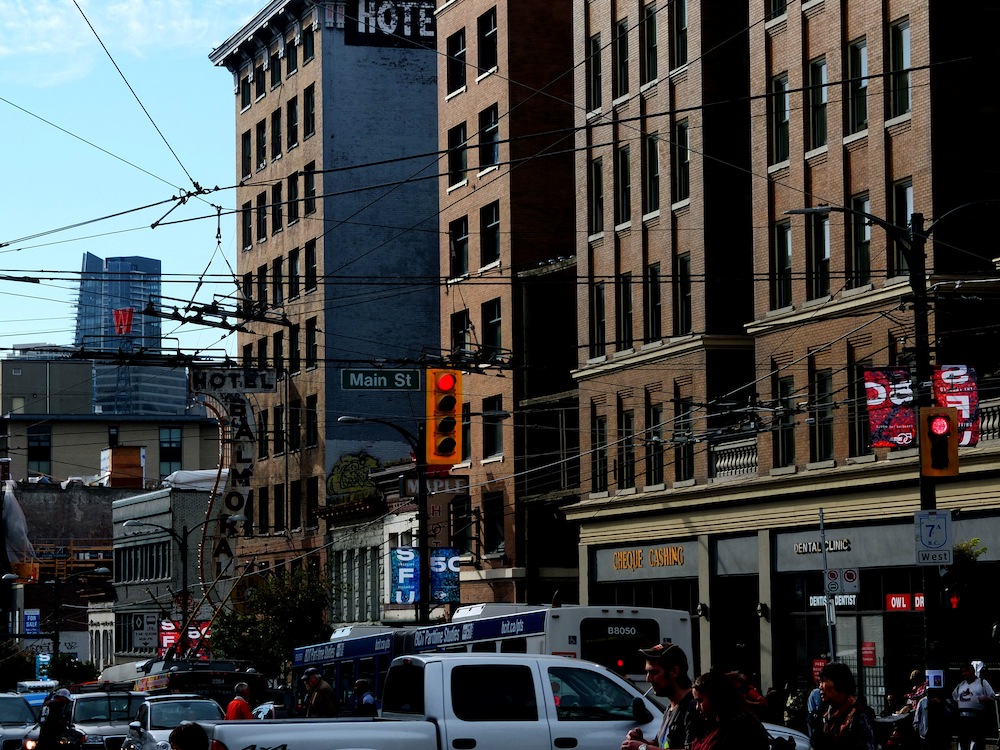
Main St and E Hastings St junction in Vancouver's Downtown Eastside
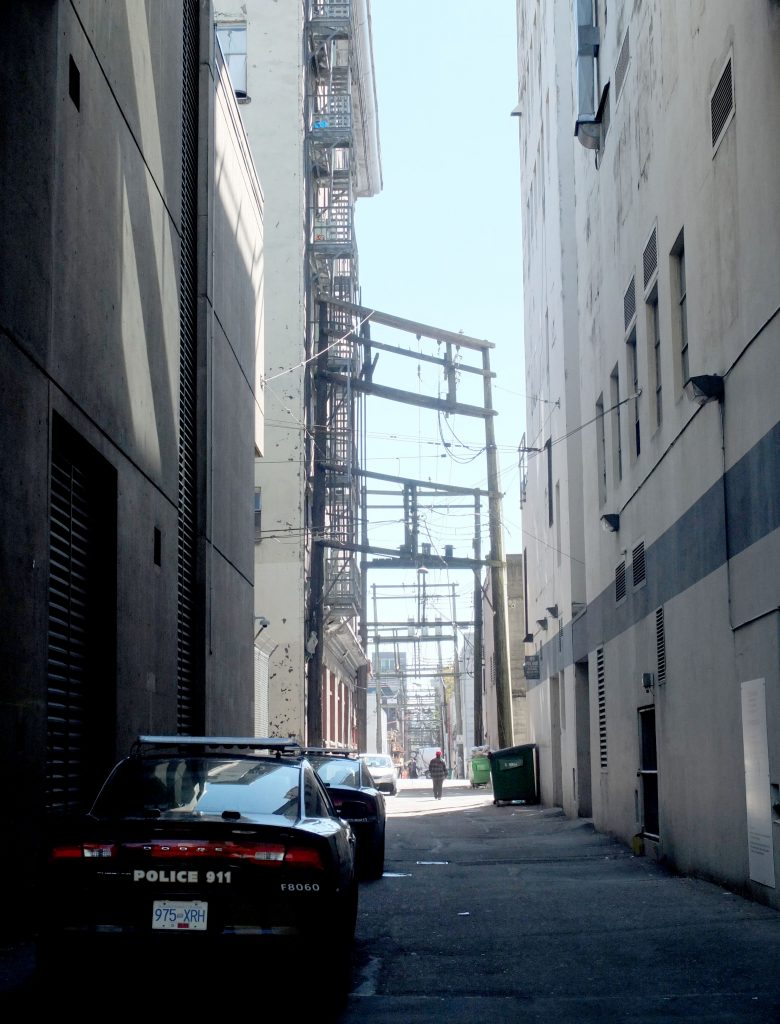
Downtown Eastside
“My name is Bruce Ray and I am a madman. I have heard voices for twenty-five years. I have always considered myself a part of a spirit world – that I relate to”
– From ‘Neurotika – Comparing Scars blog post by Bruce Ray, 2013
Ray proudly calls himself an “outsider artist”. His work exposes disturbing realities about living with mental health issues and explores the relationship between madness, oppression and art making. Importantly, it shines a light on the exasperating effects of being diagnosed and labelled with a mental health disorder: isolation, fear, numerous doctors and medication, going round and round the system – and the apparent absurdity of it all.
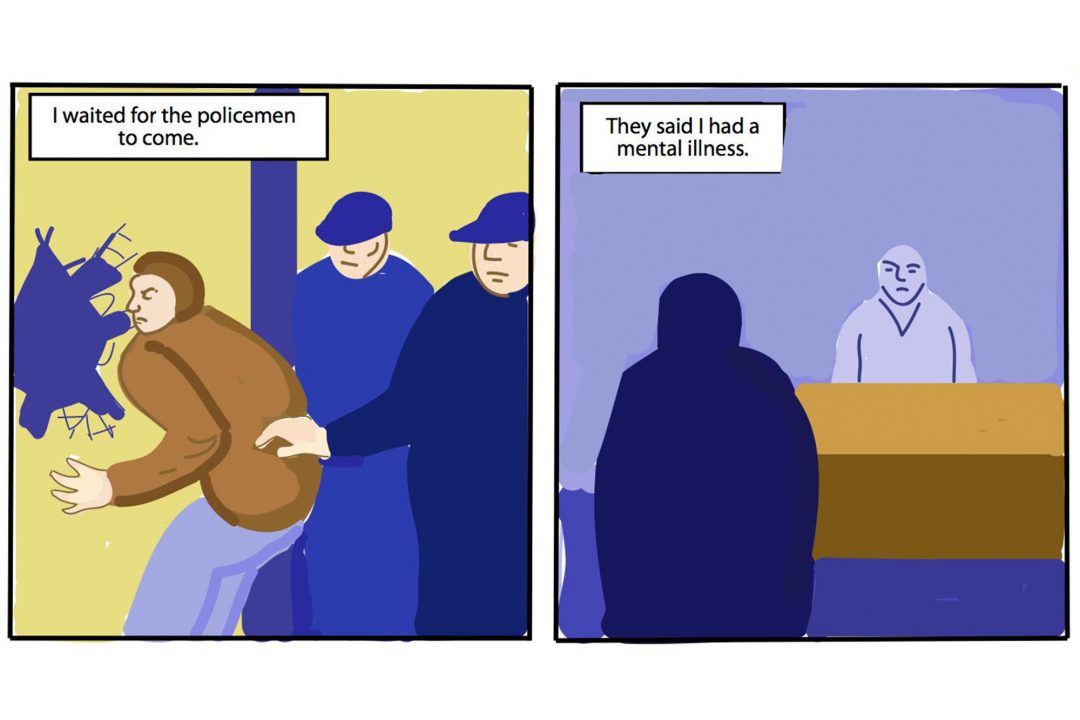
Image from Bruce Ray's 'I THREW A BRICK THROUGH A WINDOW by Jessie Byron Rae.'
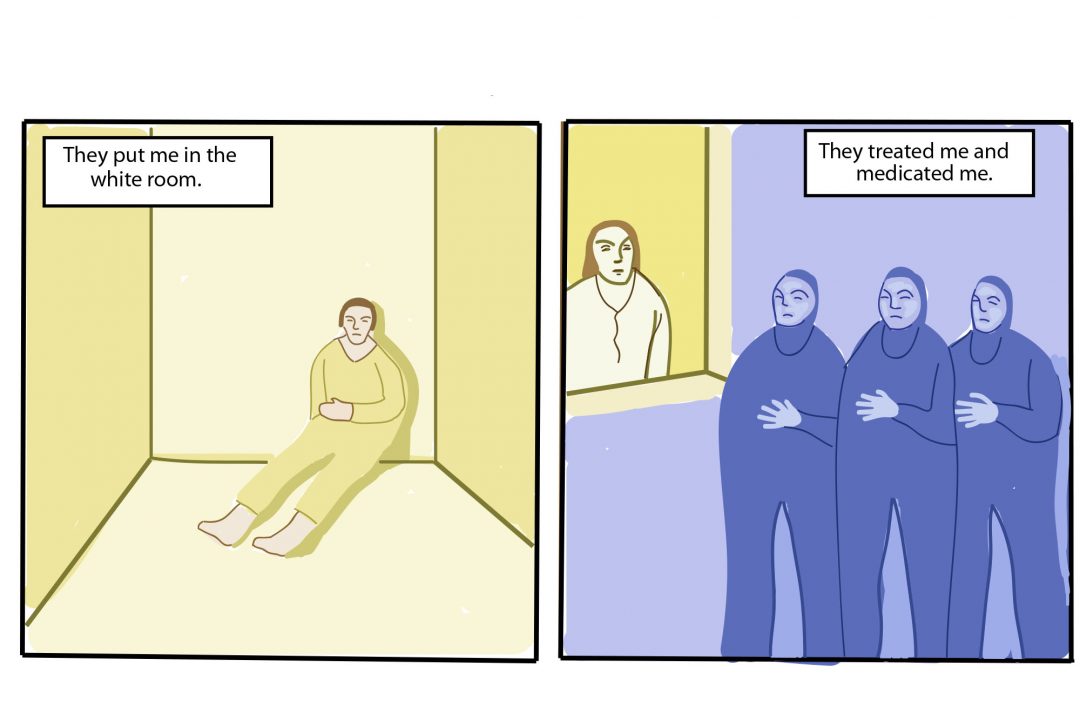
Image from Bruce Ray's 'I THREW A BRICK THROUGH A WINDOW by Jessie Byron Rae.'
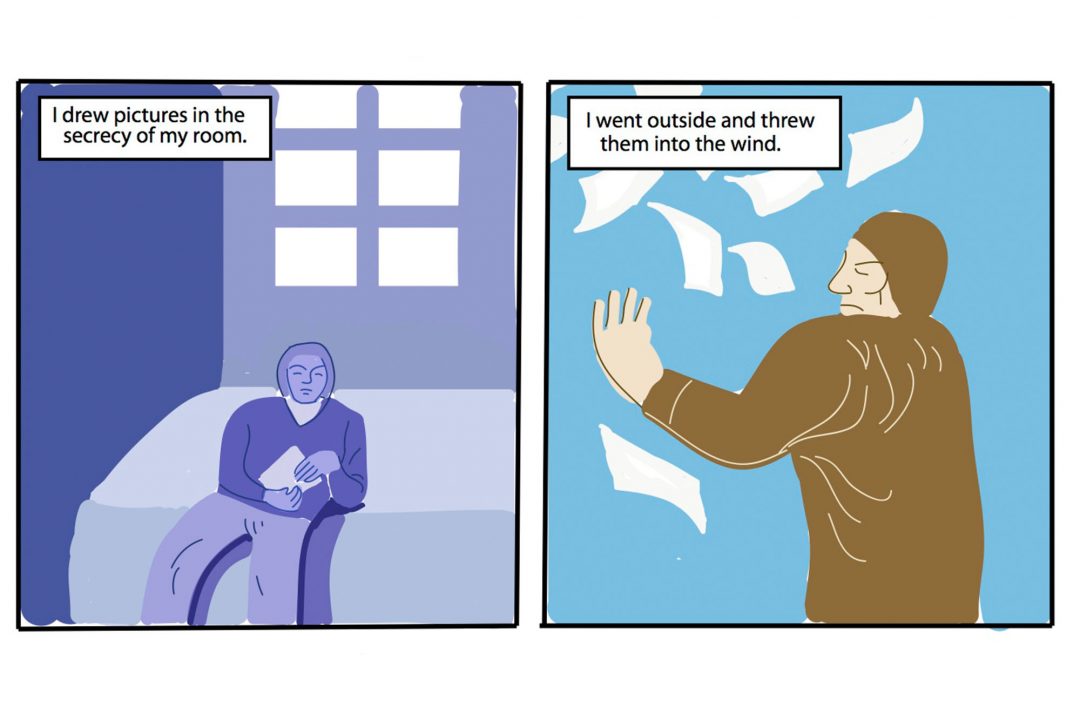
Image from Bruce Ray's 'I THREW A BRICK THROUGH A WINDOW by Jessie Byron Rae.'
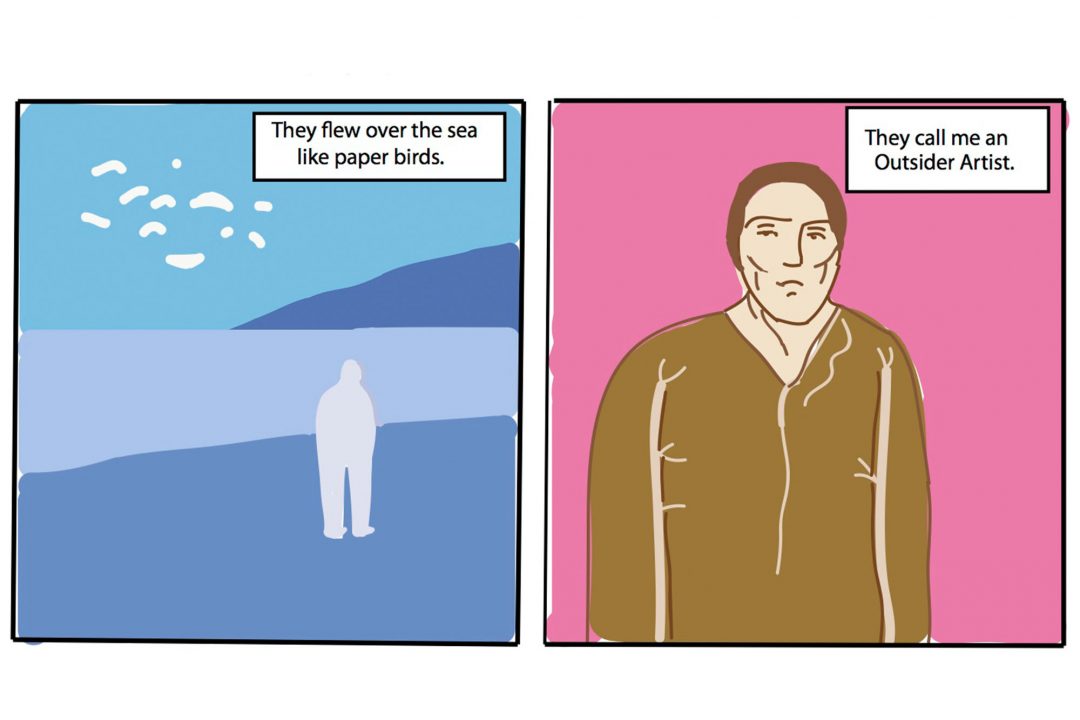
Image from Bruce Ray's 'I THREW A BRICK THROUGH A WINDOW by Jessie Byron Rae.'
When I first arrived in Vancouver and stepped off the bus into the midst of the infamous drug-fuelled swell of East Hastings’ black market to visit Gallery Gachet, I was disturbed by the tantalising intensity of the place. A pungent smell of urine and weed swept over me and I felt very aware of being yet another hot human in the crowd – living, breathing and existing.
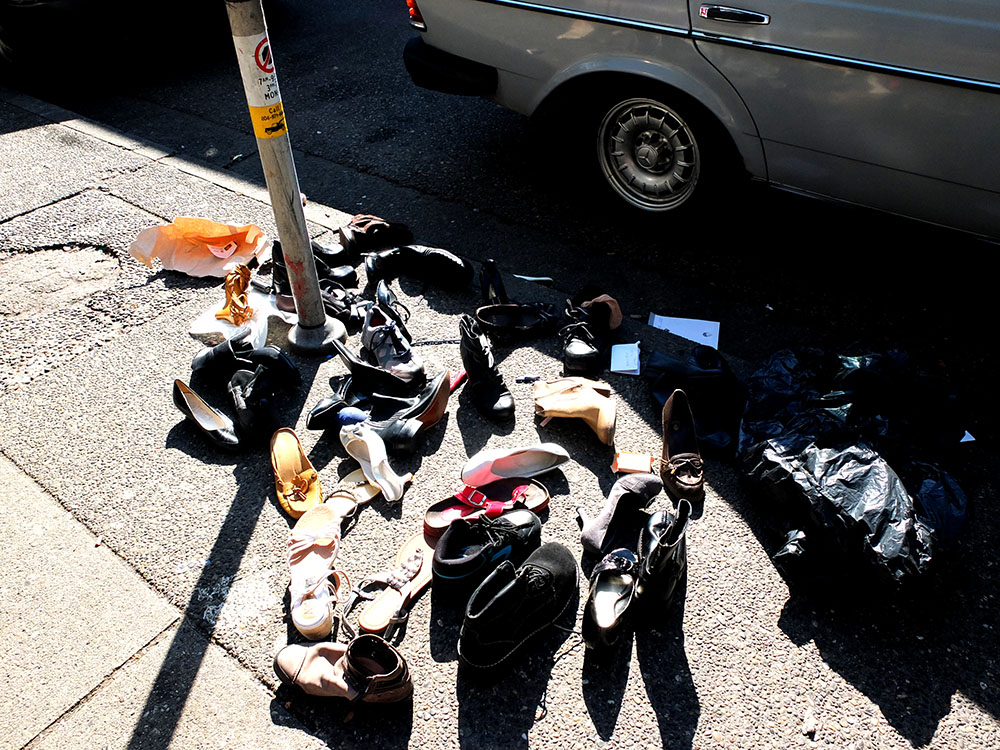
Shoes for sale in E Hasting's street market
During my visit to Gallery Gachet, I slowly got to know the DTES, meeting people living and contributing to the community there. The culture in the DTES is crucial to understanding the development of Gallery Gachet and the reason it’s creative platform is valued so highly amongst residents there.
The area is renowned for its outstanding level of activism and care. Indeed, it was here that the first legal designated injection site in North America, “Insite”, was established in 2003. Now, the DTES is made up of a large network of support services that caters for a wide spectrum of people facing addiction, mental health issues and poverty, both from the local community and across the country. In turn, this has created a unique neighbourhood that is exposed and sad but has an extraordinary core of commitment, community and recovery.
The decline can be traced back to the closure of key facilities at Riverview Hospital in the early 1990s, (a large mental health facility just outside Vancouver.) The area now acts as a prime example of the consequences that can arise where there is both delayed funding to support services and an overall failure to provide follow-up support when reintroducing people from mental health institutions back into the community. The result is numerous, vulnerable people failing to receive appropriate levels of care, slipping through the system and who end up living in extreme poverty in the DTES.
Today, it is clear that the DTES faces a mental health crisis.
Gallery Gachet
Gallery Gachet was created in 1991 by a group of artists who had experience of going through the mental health system in the area and were driven to establish a space where they could continue their art practice.
As is so often the case across the major cities in the ‘developed’ world, the area is undergoing a process of gentrification. Cafes, shops and restaurants have started to emerge in the DTES and now the authorities are attempting to ‘revitalise’ the area: plans are already in place to convert affordable housing into expensive ‘condos’, with the intention of pushing out the resilient community that’s been surviving here for decades. While I was visiting, Gallery Gachet itself was bearing the brunt of this wave of gentrification with tragic news that the organisation’s core funding had been cut from the Provincial Ministry of Health after twenty-one years.
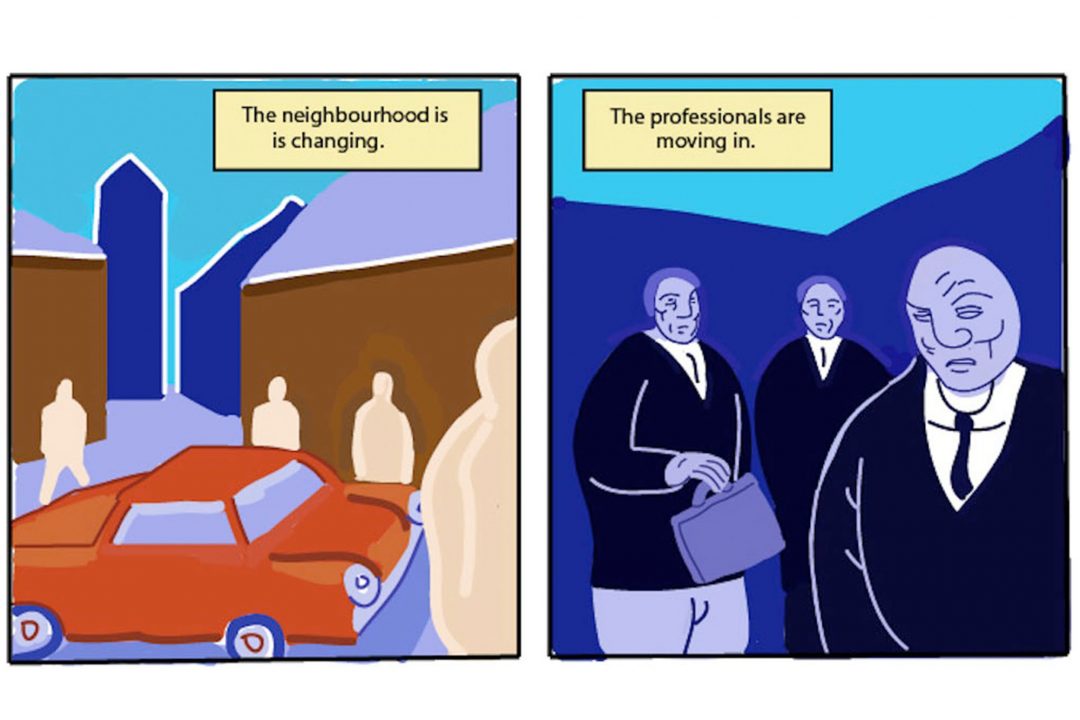
Images from Bruce Ray's 'The Keeper by Jessie Byron Rae.'
“[Gallery Gachet is] a space to amplify voices, to connect people, mentors and outside thinkers but it needs to be in a place, not just in a building but in a neighbourhood and in a community that is cohesive and also makes sense. And so that is the Downtown Eastside for Vancouver both symbolically and practically. It’s just a very meaningful place for some of our most marginalised and vulnerable individuals in this city and in Canada.”
– Cecily Nicolson, Gallery Gachet Finance Administrator
“One of the saddest things that I’ve seen is that a lot of [people] were pushed out of the safe facilities/institutions and they were left alone to fend on their own and that was one of the greatest atrocities that Canada has ever done to our special needs with mental health [community.]”
– Interview Stephen Lytton, actor and community advocate
“Ambiguities are what bother the mind of a soul caught in mental illness. When you are insane or mad in some way – you are faced with the enigma of the dark unconscious mind”
– From ‘Neurotika Blog – Ambiguities’ by Bruce Ray, 2013
Bruce Ray joined Gallery Gachet over fifteen years ago and is currently the elected President of the organisation. He makes art in the studio everyday. I met him one grey and drizzly morning in early September to discuss the impact that joining Gachet has had on his life and his view on the important role of the organisation within the wider mental health community.
“We seek to release stigma from our lives – to show others we are able to overcome the shame of living on the borderlines of madness”
– From ‘The Alternative Vision’ blog post by Bruce Ray, 2013
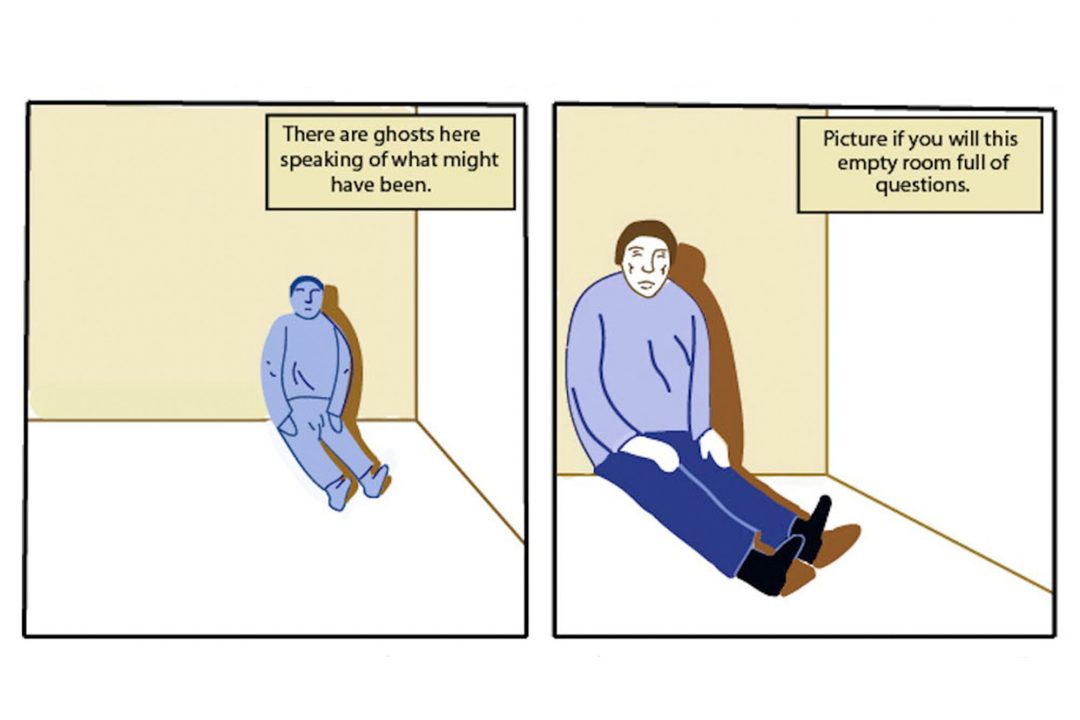
Images from Bruce Ray's 'At The Gallery by Jessie Byron Rae.'
I travel down to the gallery by bus, crossing through the East Hastings street market, where people had already started to crowd the streets to sell odd bits and bobs that I’m told are often uncovered from bin raids. I get to Gallery Gachet at around 9 and Ray says that he’s already been working there for a few hours. He explains that he usually comes down to the space very early in the morning so that he can use the computers before anyone else arrives. Ray was recently taught how to use Adobe Illustrator, which has transformed the way he creates work.
Ray’s relationship with the gallery, like most of the other Collective members that I met is an intimate one, with the space acting almost like a second home. “I just walk into the room and…feel such good vibrations”, he says as we sit down to start the interview.
Ray tells me how his work is inspired by his own experiences within the mental health system, “I see myself as a storyteller” he says, “I’m kind of wondering who is the insider and who is the outsider?”
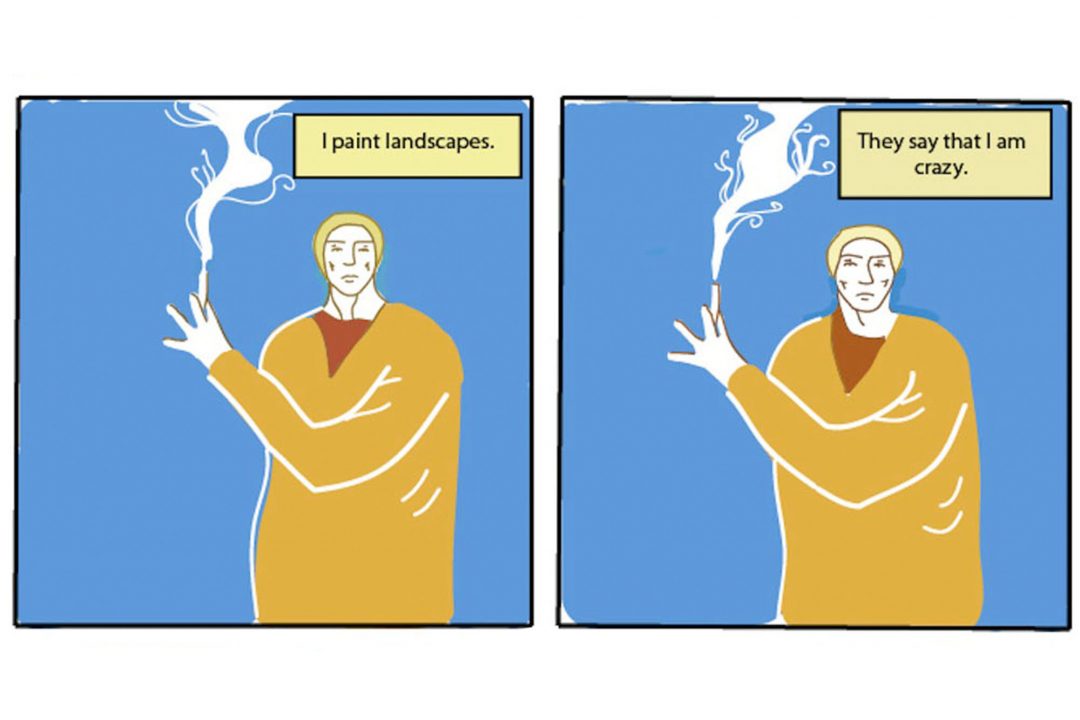
Image from Bruce Ray's 'The Keeper by Jessie Byron Rae.'
Ray describes himself as an illustrator. In his recent comics, we are taken to a surreal pastel dreamscape where we slip between places, faces and ideas. There’s stillness amongst the drawings, the characters are trapped within the worlds they inhabit. Their wide bodies remind me of Henry Moore sculptures – lonely and motionless. Placed within the greater landscape, they are hunched over, perhaps by the weight of their thoughts or the oppressive system that tries to control them.
“Mental illness is indeed a confusion -but it is also a transcendence and yet an acceptance. We learn that reality is so much more than just a series of events that follow a history of decisions… You are not certain and you have difficulty in understanding the visions that arise out of the emptiness”
– From ‘Neurotika Blog – Ambiguities’ blog post by Bruce Ray, 2013
Ray’s work constantly reminds us of time – the passing or lack of it. While the van drives away in ‘Olympiad’, a man continues to whip a horse in the street, while somewhere else a figure sits in a timeless cube “left with nothing”.
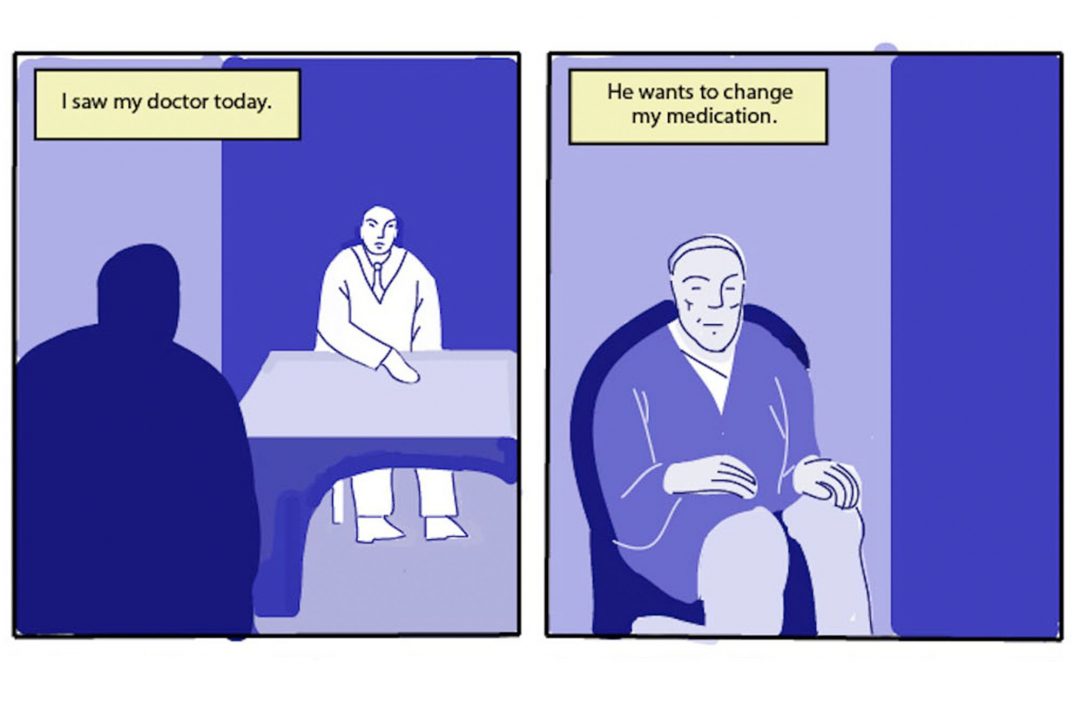
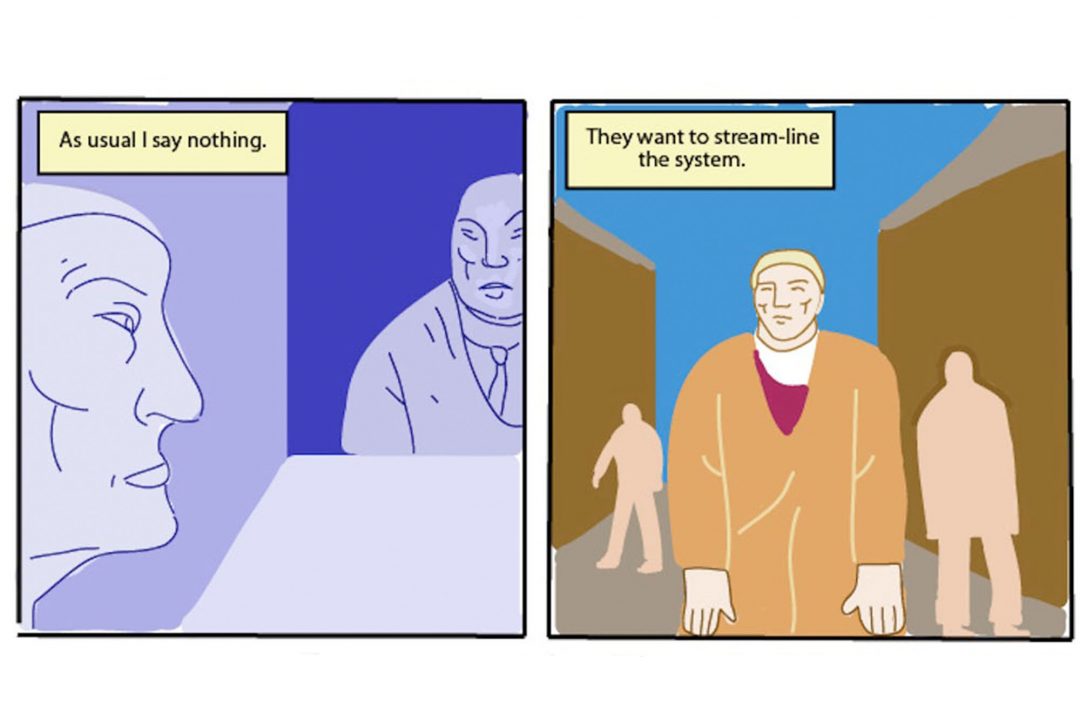
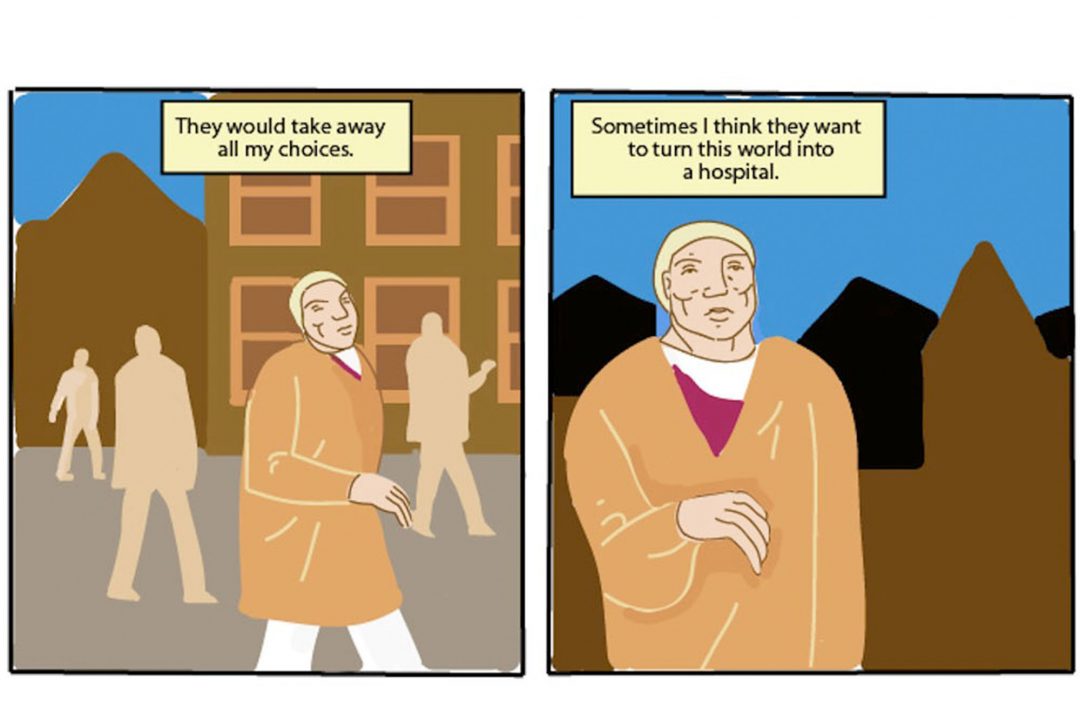
Images from Bruce Ray's 'The Keeper by Jessie Byron Rae.'
His stories distort reality, suggesting that nothing is real anymore, “the buildings were facades like corrugated cardboard” where nightmarish people “who have no faces” come and take us to a white room where expression is not allowed and we are left alone.
Ray’s vivid worlds provide us with an insight into the intense pressures that living with mental health create for some people and in particular the alienation from any normal ‘system’.
The Collective
“I think that people should have work to do, I think that if you have work then you have a sense of pride and self esteem”
– Interview with Bruce Ray, 2015
Listening to the way Ray talks about his involvement with the Collective, I am deeply inspired by what they have managed to offer the mental health community in Vancouver.
The organisation is far more than a place to make art. What is unique is the collective working model that has provided people with an opportunity to participate within an active working environment – one that is shaped to support a variety of differing minds.
Artist Laurie Marshall discusses his relationship with Gallery Gachet
The Gallery
Gallery Gachet’s current location is a far cry from the original basement space that the organisation once occupied. The building now consists of a large, back-room studio that Collective members are allowed to work in, with a street front and bright, spacious gallery space.
The gallery is the Collective’s central focus. The Collective work together to programme a diverse range of contemporary exhibitions and events that aim to tackle challenges faced by the DTES neighbourhood and wider mental health and disability communities. Gallery Gachet sees itself as a platform for these under-represented voices and ensures that the space remains an environment for experimentation and collaboration.
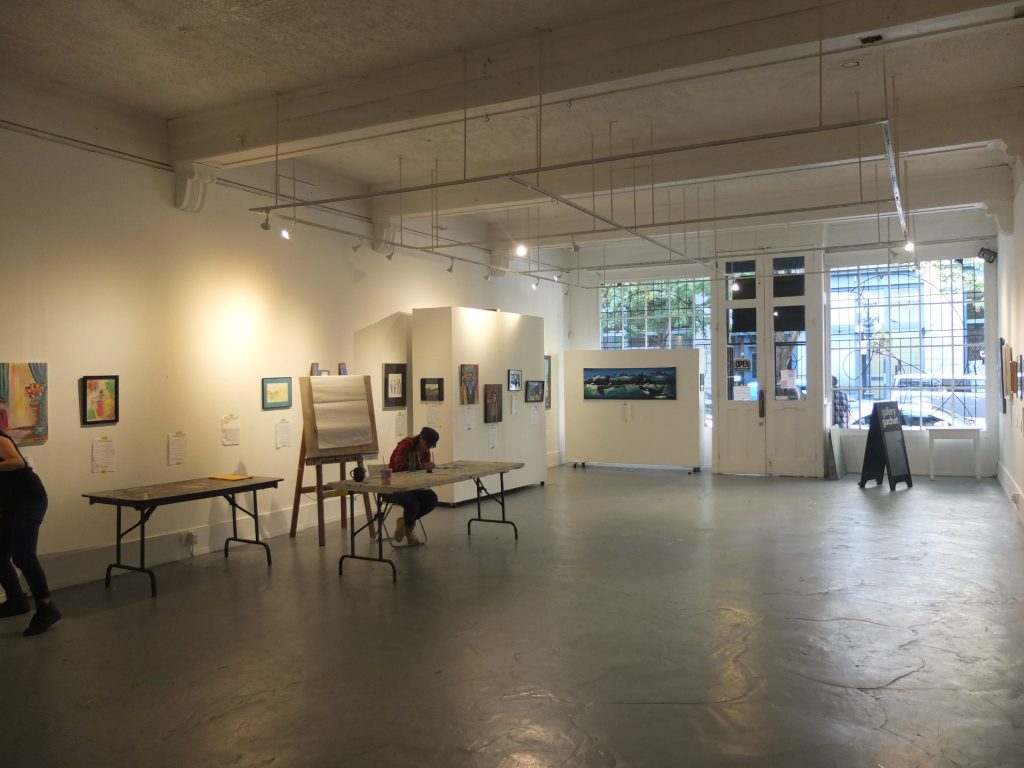
Gallery Gachet
“We educate the public about stigma, stereotypes of mental illness as well as educate ourselves about the business of art.”
– Interview with Bruce Ray, 2015
Gallery Gachet is constantly seeking out collaborations with other art projects in the DTES area and often provides a facility for those who don’t have a space of their own. Exhibitions such as In Between that I helped to install during my visit, showcased the work of artists from the Oppenheimer Park community arts programme that works with homeless and low-income residents in the DTES.
In Between offered artists an opportunity to see their work within a contemporary art context- something that Gachet provides to many artists. The show was an eclectic mix of styles and techniques; dried out vegetable puppets, detailed illustrations, large paintings and my favourite – a gently dusted pastel drawing of a cat.
The exhibition brought the DTES community together. On the opening night there was a joyous celebration that kicked off with a parade, led by a marching band, through the DTES. As we paraded through the streets, many people who had been sitting on the pavement joined the procession, taking a handmade shaker and dancing all the way back to Gallery Gachet for an after party. This was a fun, inclusive way for the curators of In Between to let people in the community know about the exhibition and ensure that they felt welcome to participate.
How the Collective Work
The Collective “lends itself more to the idea of equality in equity then any other model”
– Cecily Nicolson, Gallery Gachet Finance Administrator
Along with a core team of four paid staff, the Collective hold monthly meetings where all organisational decisions are based on consensus. Cecily Nicolson, Gallery Gachet Finance Administrator, explains that the decision making process can be slower than the usual hierarchical model because they work with everyone in the Collective to ensure that all decisions “make sense”. The idea of having an art space where participants with mental health issues have the “power to make decisions similarly to a paid staff, presumably of sound health” is “a better model in the long run because everybody comes out more prepared to actually participate in the structure and it actually decreases a kind of dependency on the service.”
“There’s a clear deliberate effort here to build a non hierarchical environment, so creating care and support and services…in an environment where those who are needing that care and support are part of the decision making and a part of deciding…how the services should be offered .”
– Cecily Nicolson, Gallery Gachet Finance Administrator
Being part of the Gachet Collective offers artists a rare chance to actively contribute towards the running of an organisation. In turn the Collective members have gained invaluable skills – teamwork, management, trust and a chance to learn how to run a contemporary art space.
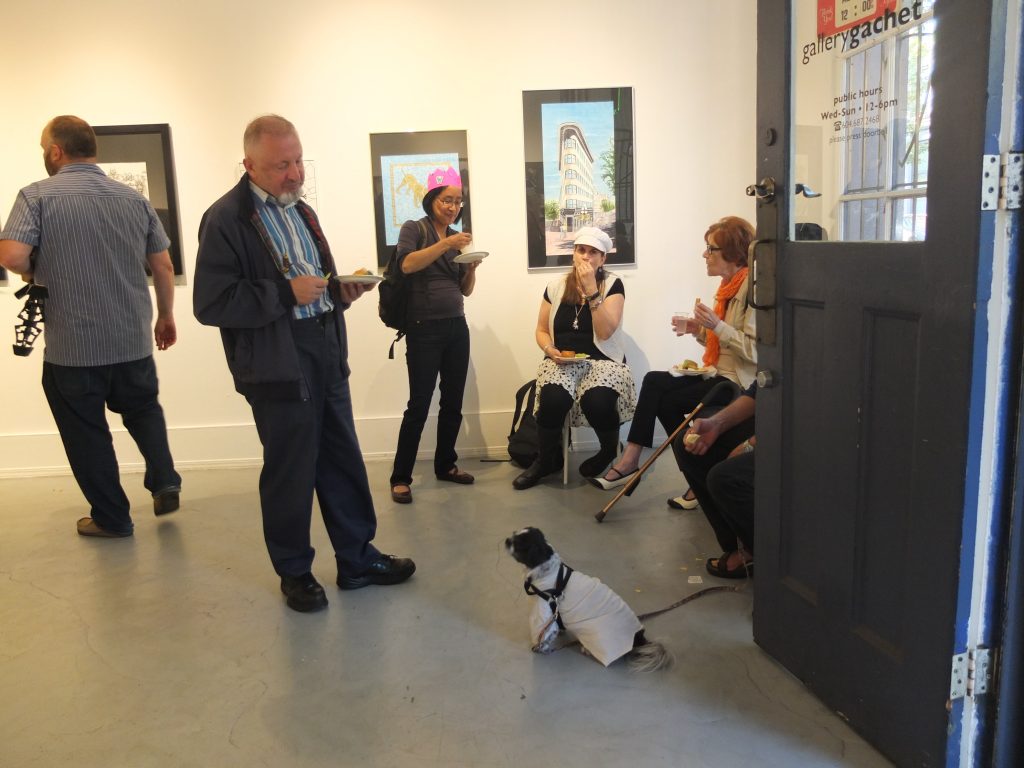
Exhibition opening at Gallery Gachet
“It really empowers people; I’ve been involved [in] mental health for many years and I see a lot of people that just don’t have the pride or self esteem of doing something creative in their lives and here there was a forum for such people to see art as a therapeutic practice”
– Interview with Bruce Ray, 2015
In order to operate smoothly, the Collective have developed a complex system with a set of principal ‘rules’ that new members must study before eventually being able to join and participate in monthly meetings, assume extra responsibilities and have access to the space to make work.
There is even a clear system in place called ‘Relationship Repair’ that helps members address personal problems that may arise within the group. I found this honest approach to acknowledging that disagreements are inevitable within a work place extremely refreshing.
“That balance takes work, takes time but it lends itself more to the idea of equality in equity then any other model. It also lends itself to other forms of communication and relationship building. By that I mean for example, meeting structures that depend on consensus, meeting structures that are facilitated with outcomes…that have to be shared.”
– Cecily Nicolson, Gallery Gachet Finance Administrator
Gachet’s attitude towards supporting artists with mental health could indeed be considered “radical”. Nevertheless, what started as an experiment has proven twenty-three years on to not only function as a fair and effective organisation, but also provides numerous benefits and support to the Collective members..
What is fundamental to Gachet’s success is the stability that the space offers people. A contemporary art space can offer more than the regular drop in centre model. It can inspire participants to be part of something exciting and important. Purpose and a sense of pride among the participants are in abundance.
“I really feel that we’re the alternative to the regular systems, the regular status quo of mental health as regards to drop in centres and clinics and group homes. I think that we are the other way of doing things – it’s an experiment, a really good experiment that seems to work out and it has definitely empowered the members as well as people who come to join it.”
– Interview with Bruce Ray, 2015
Read Bruce Ray’s full set of illustrations below
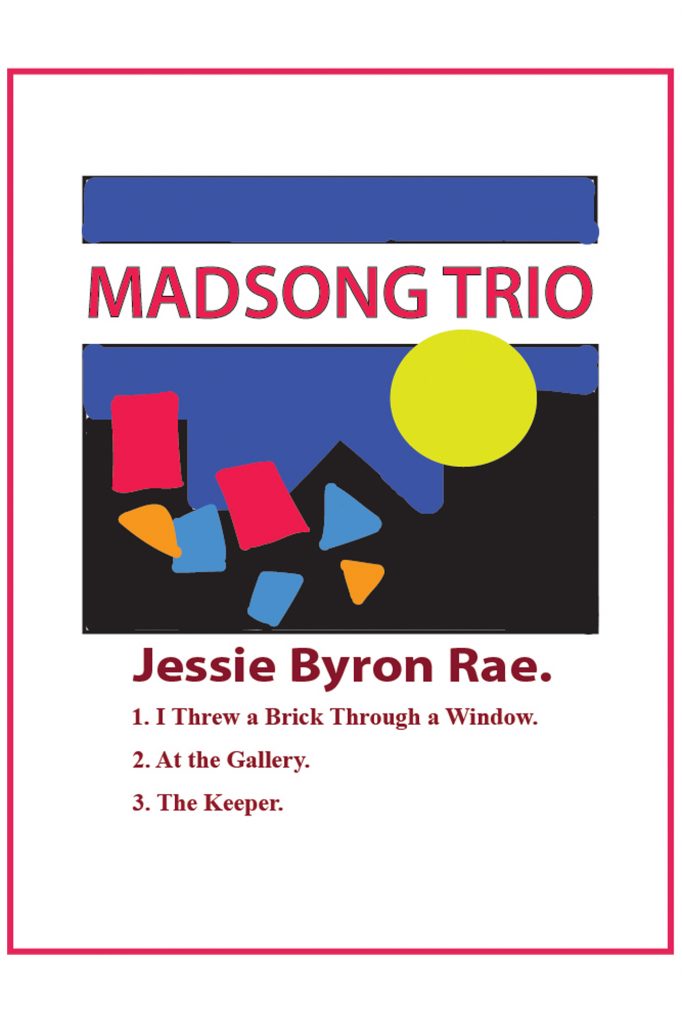
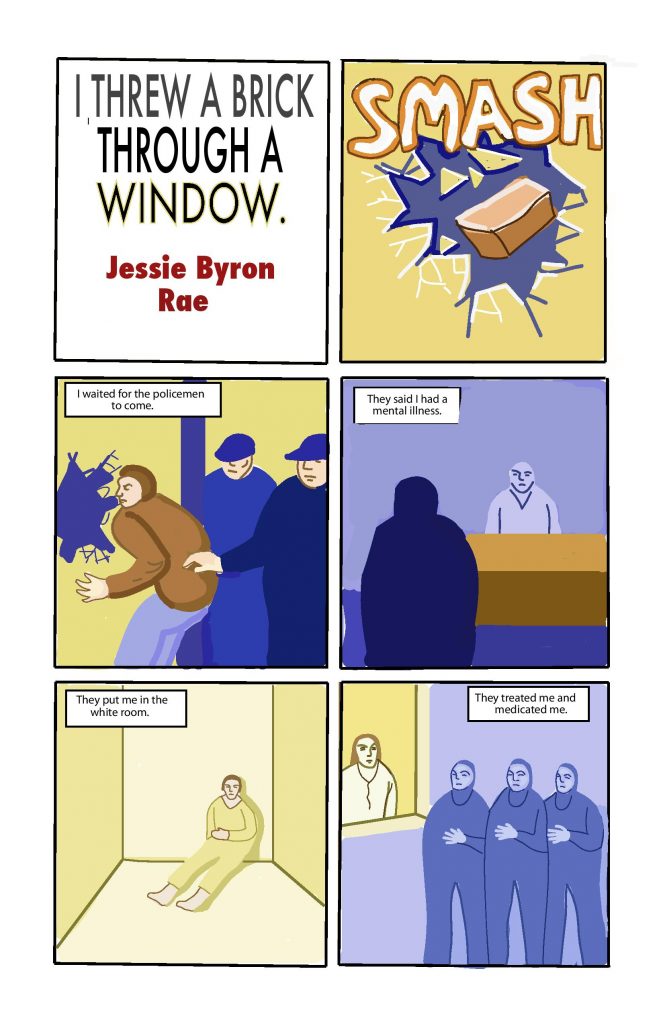
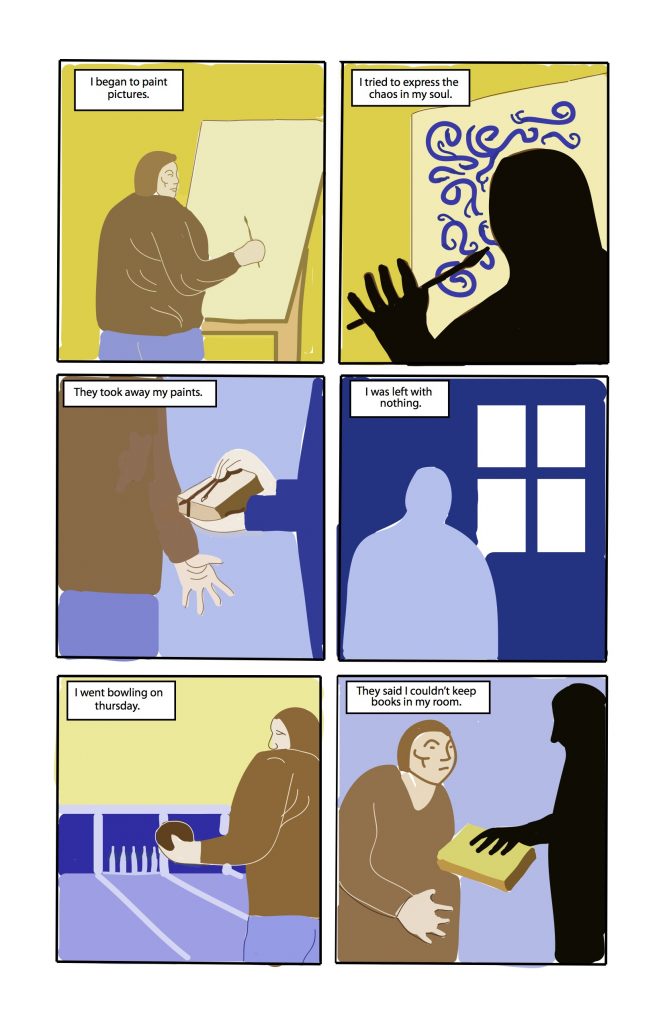

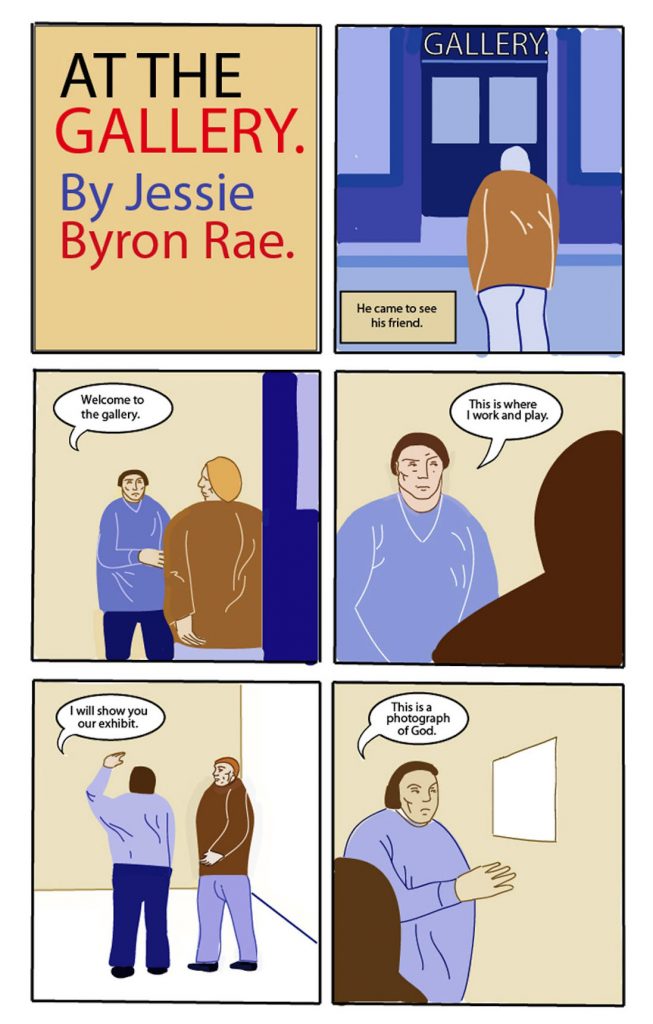
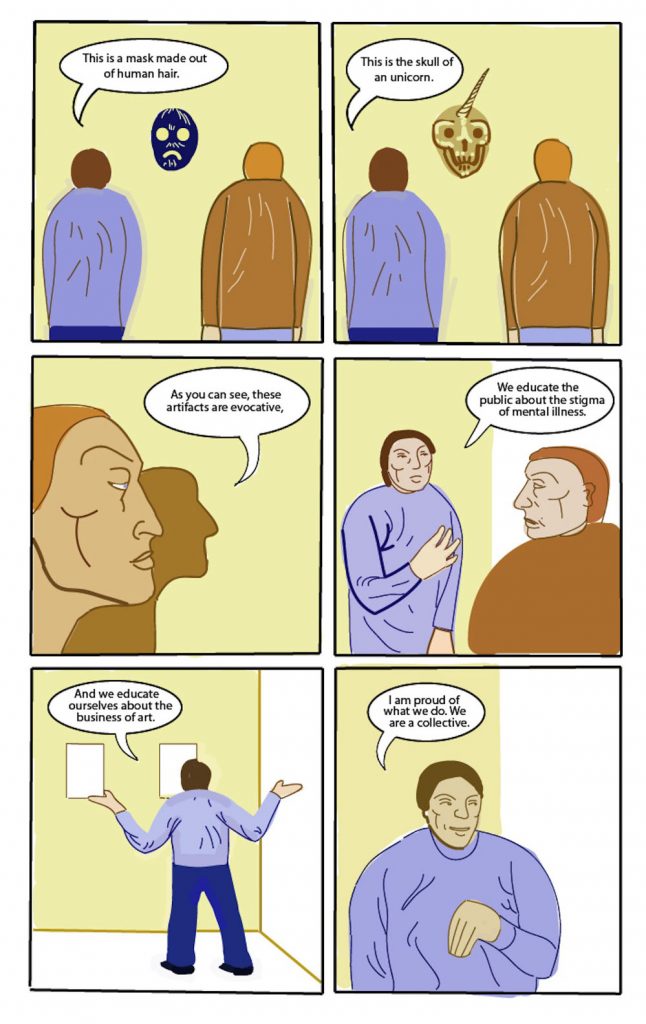
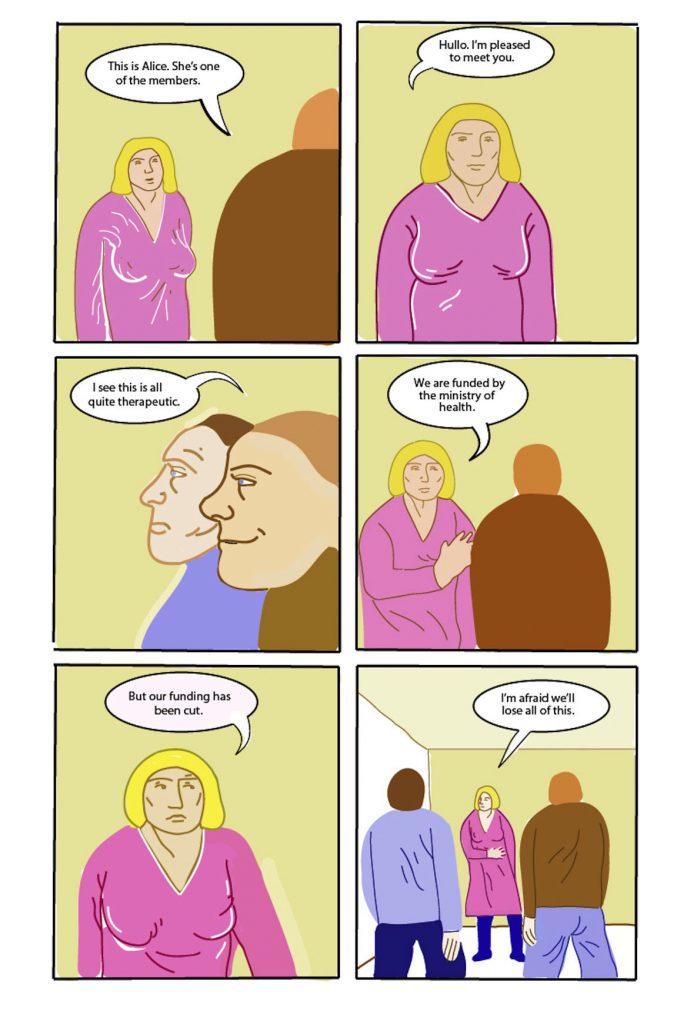
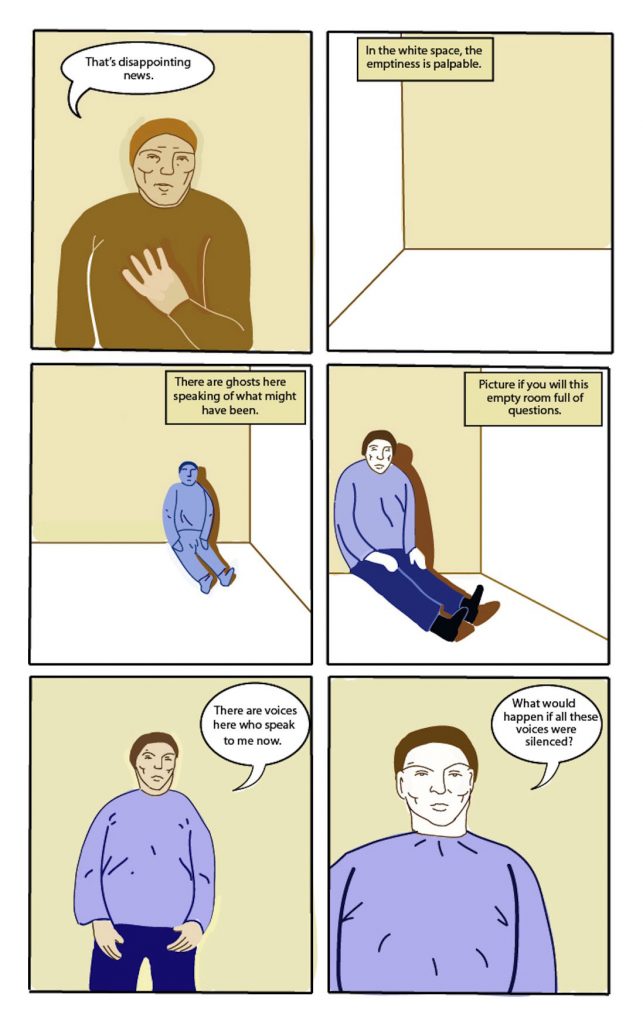
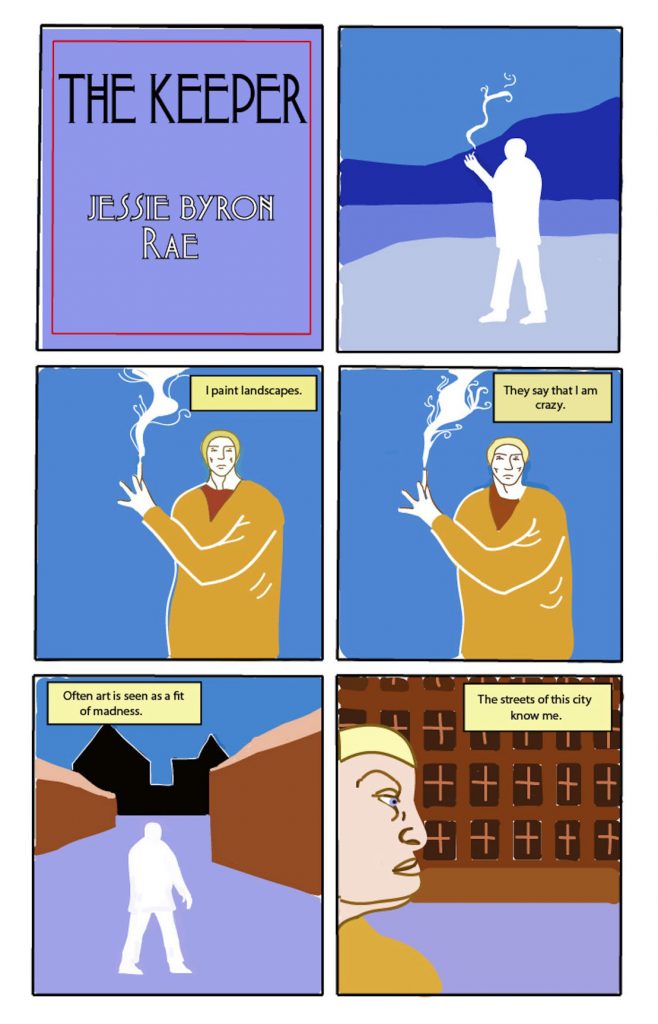
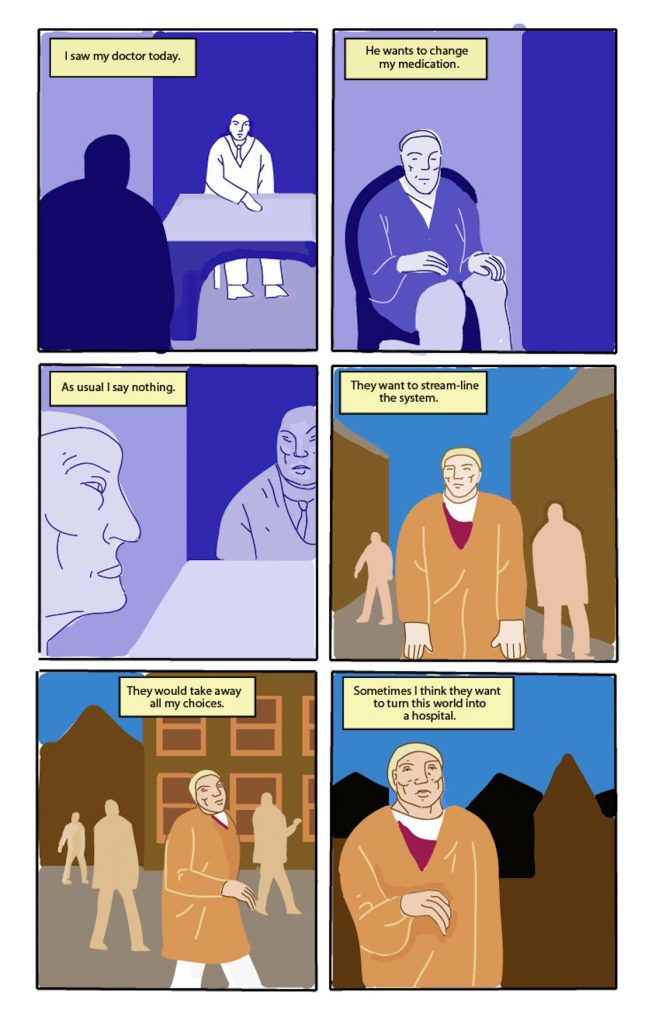
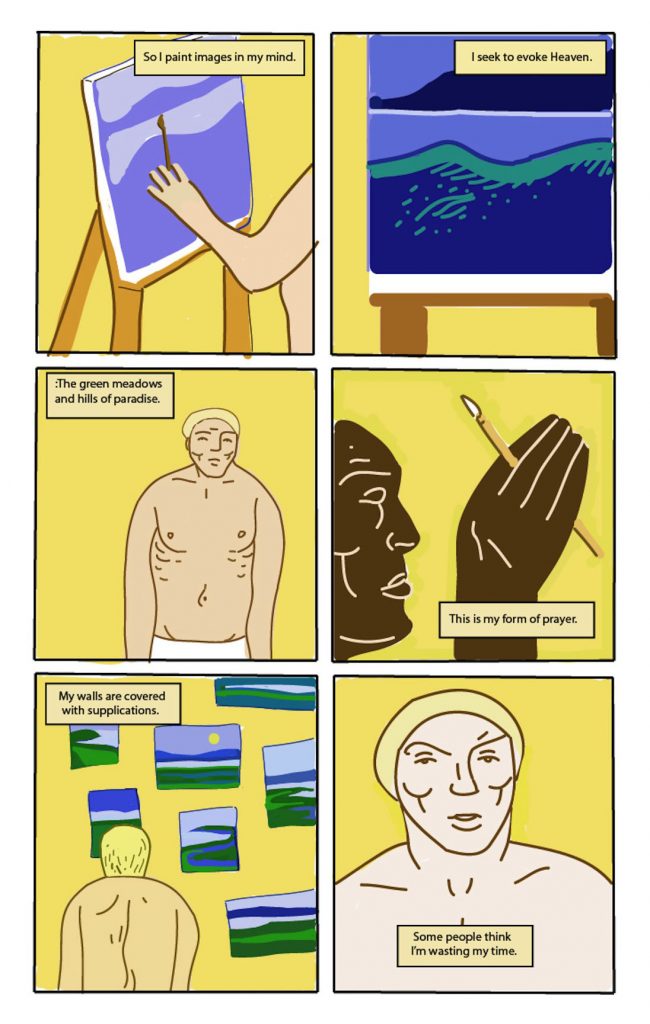
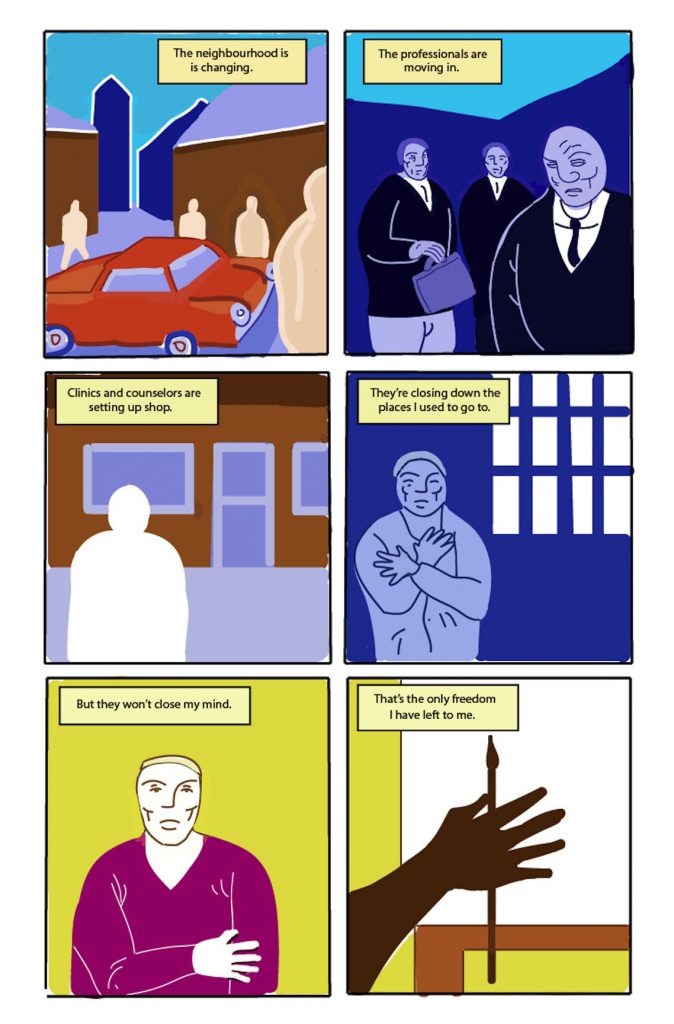
Read the next article here: The Skid Row History Museum